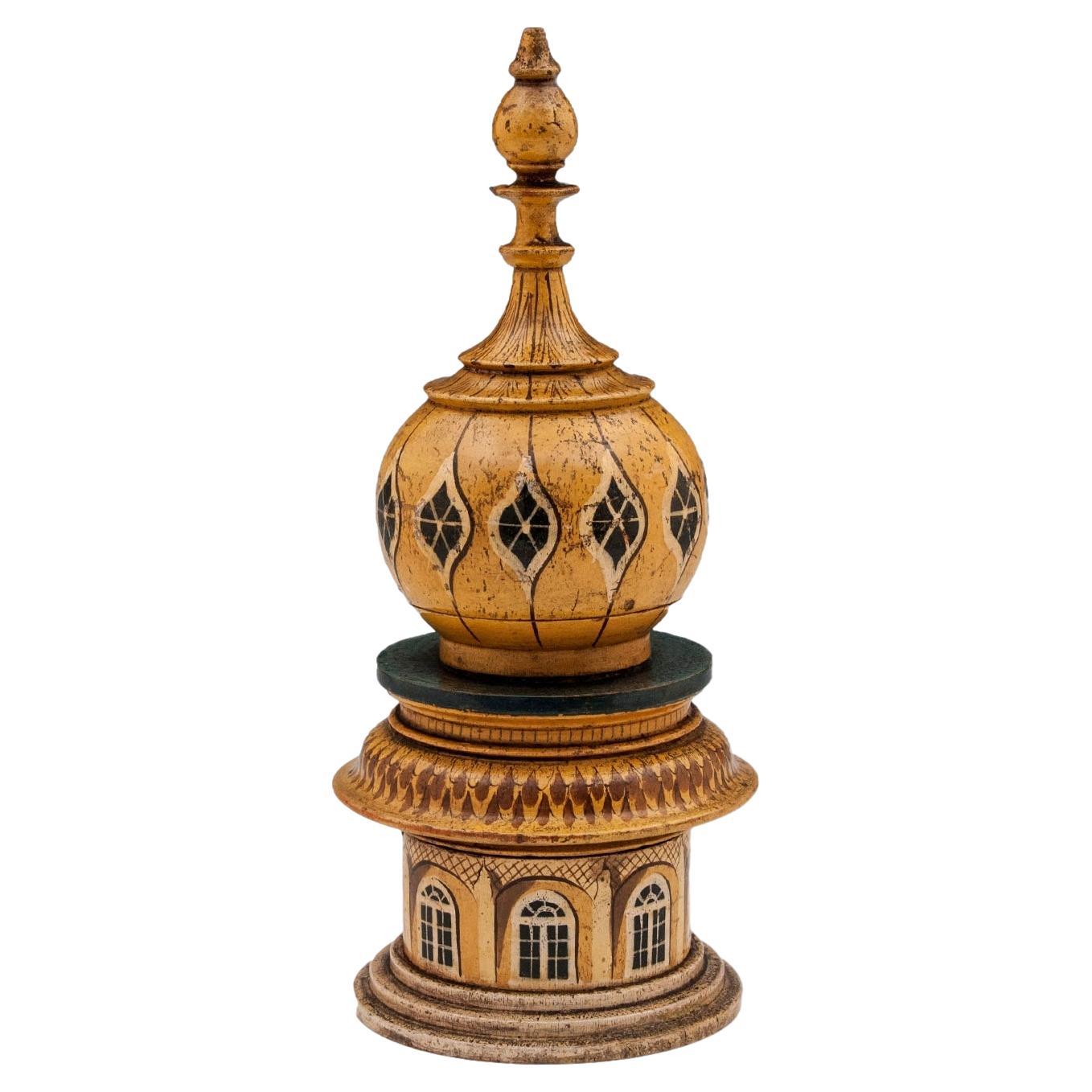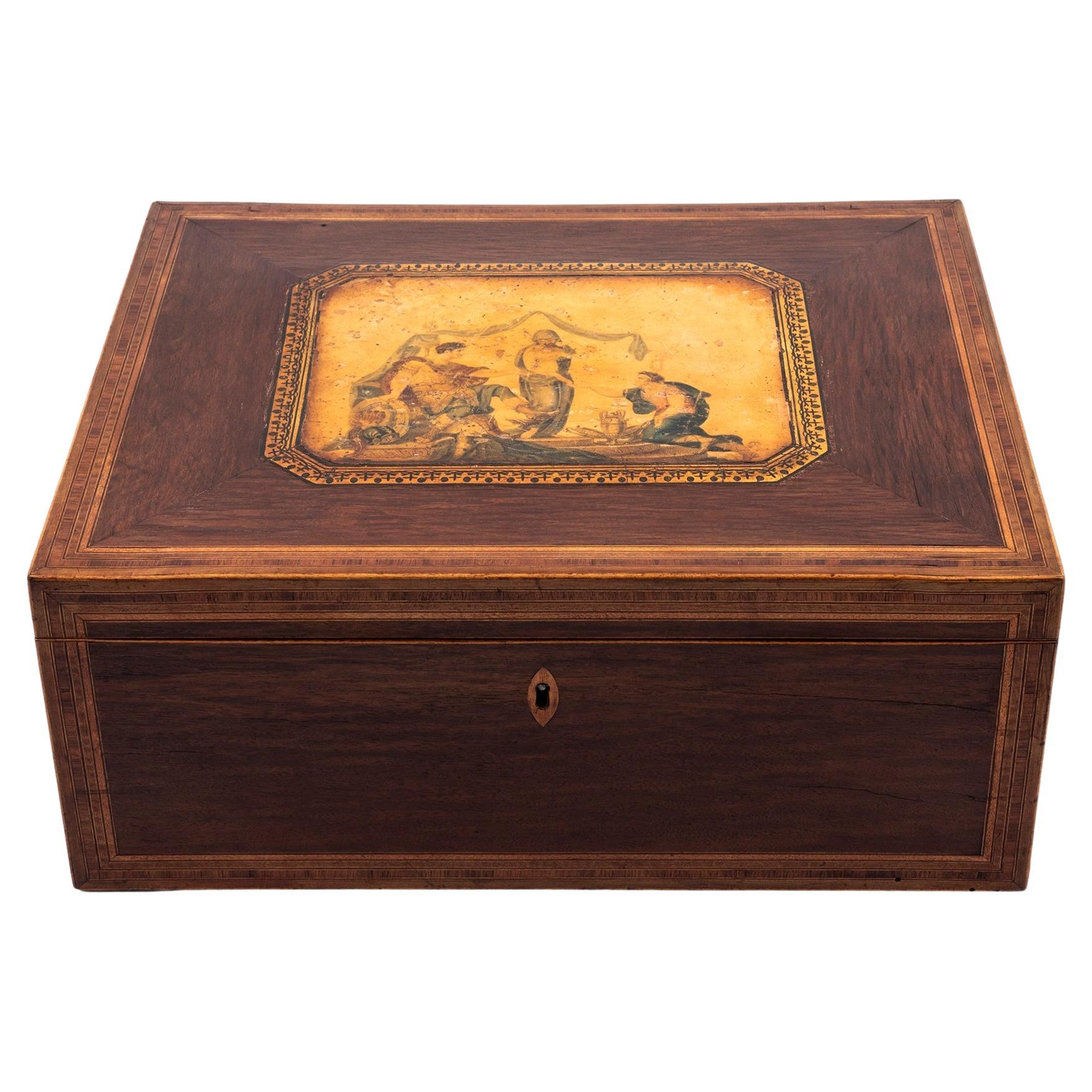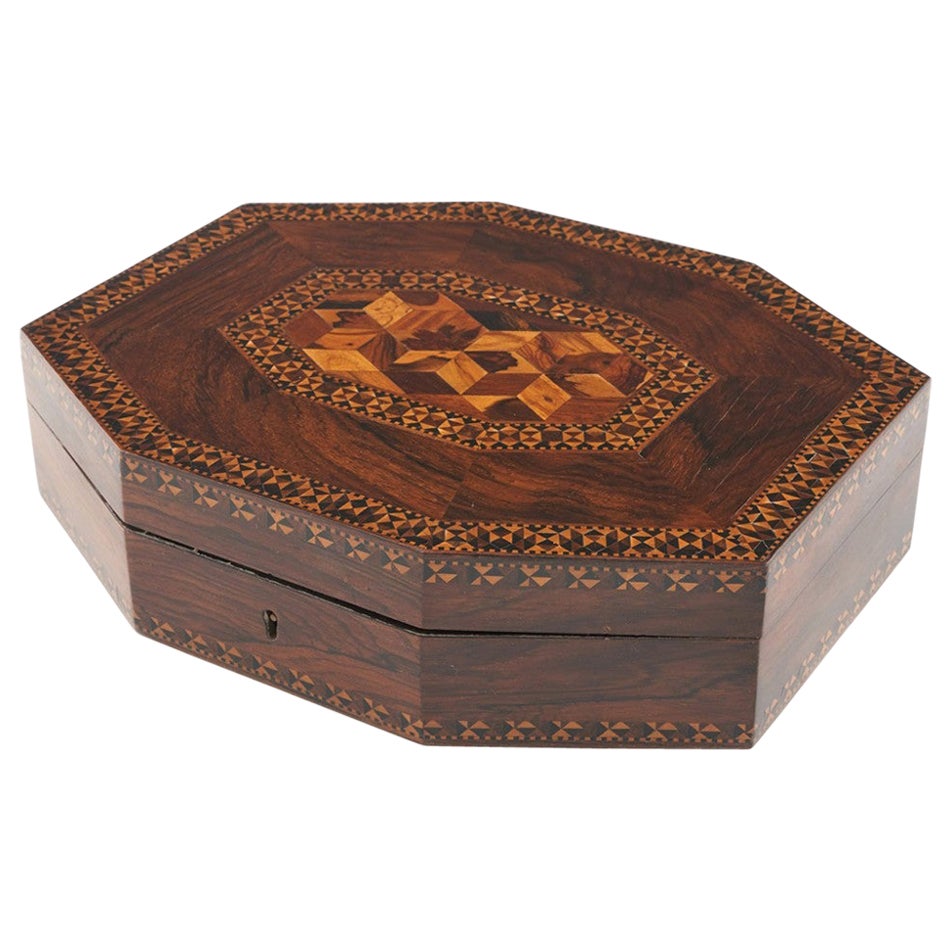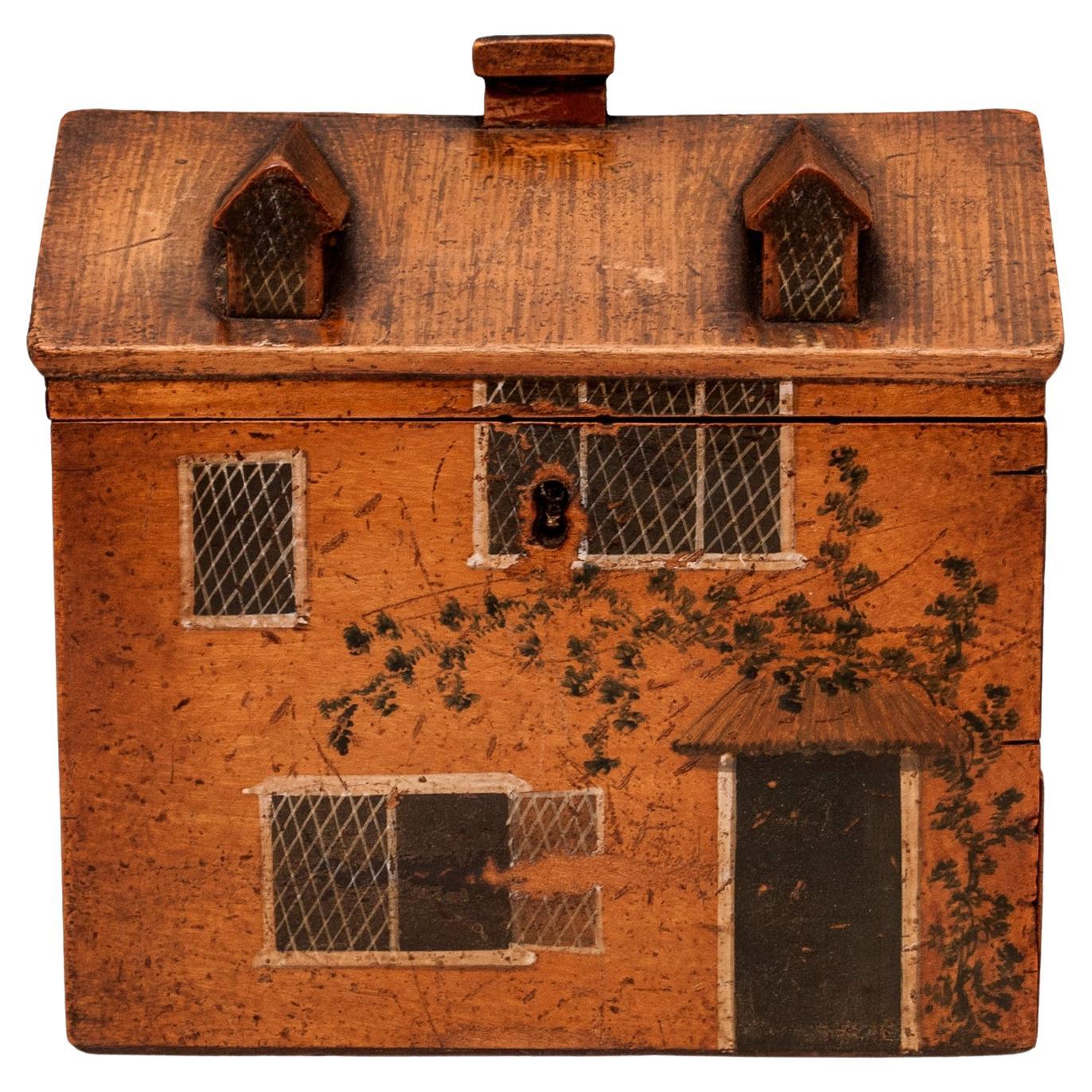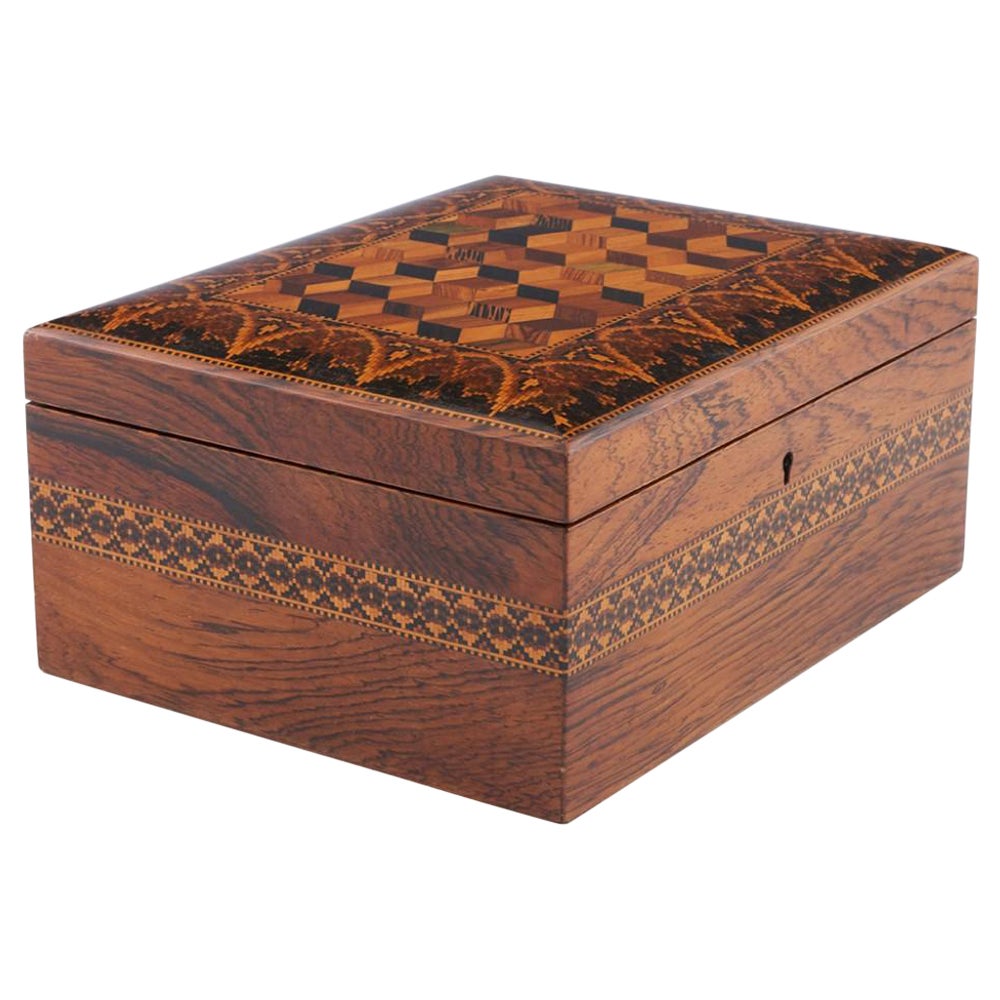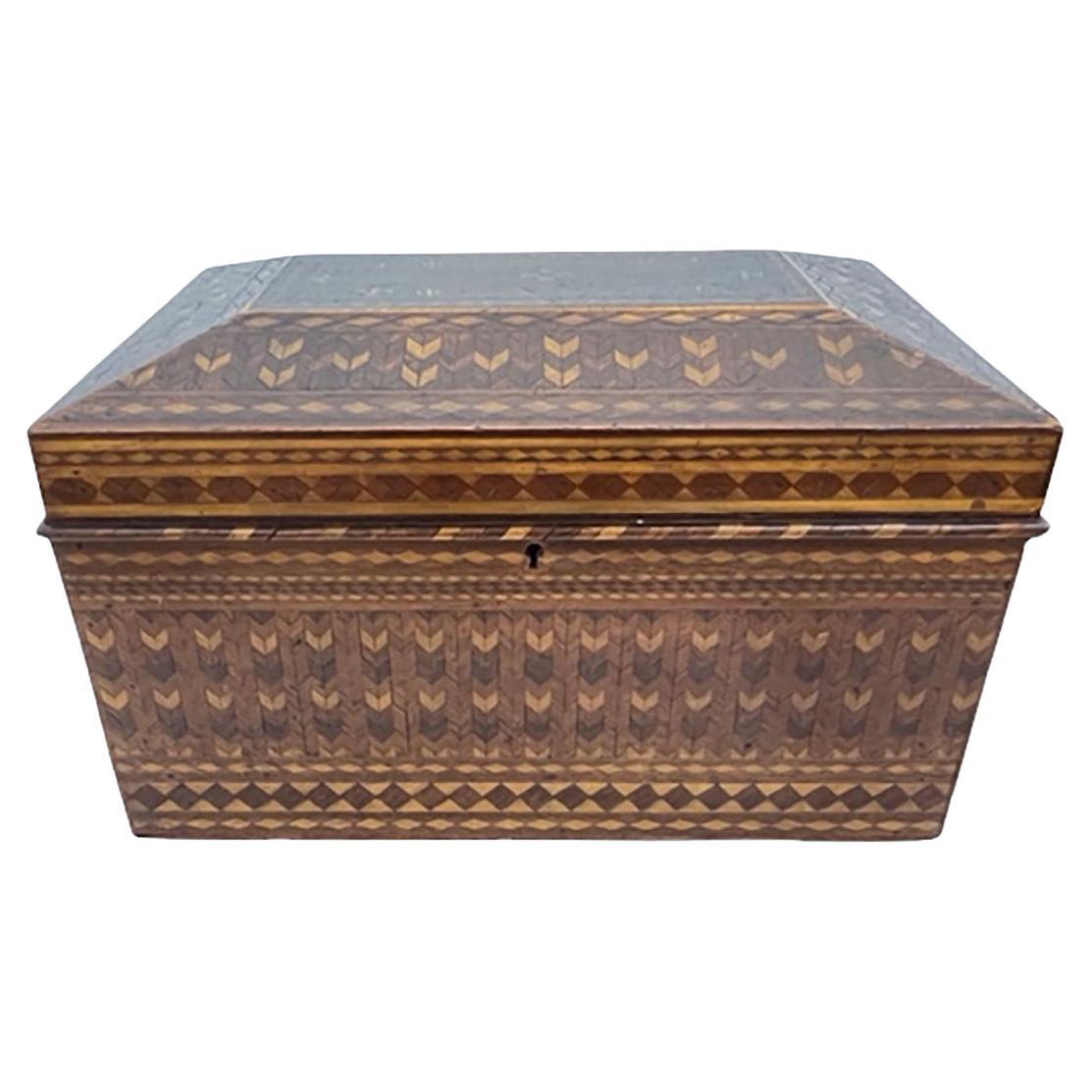Items Similar to Tunbridge Ware - An Early Sewing Box with Mounted Brighton Pavilion Print, c1820
Want more images or videos?
Request additional images or videos from the seller
1 of 11
Tunbridge Ware - An Early Sewing Box with Mounted Brighton Pavilion Print, c1820
About the Item
Tunbridge Ware - An Early Sewing Box with Mounted Brighton Pavilion Print, c1820
Additional Information:
Heading: Tunbridge Ware - An Early Sewing Box with Mounted Brighton Pavilion Print
Date : c1820
Period : George IV
Origin : Tonbridge and Brighton; England
Decoration : A lightly-figured amboyna ore perhaps elm-veneered box, rectangular, tapering towards its base; hinged lid with canted edges, decorated with a pen or sponge-work border; to the centre, a coloured etching showing Brighton Pavilion with gilt-decorated border; metal ringed cornucopia handles to both short sided; diamond-shaped inlaid bone or mother of pearl escutcheon; raised on four spherical brass feet. Internally, a large single well, with ledged sides on which sits a deep tray; this is divided in to sixteen sections to include: needle book and reel compartments; a small pin cusion; thimble holders and a rectangular compartment with its own lift-out lid; all lined with the original pink paper.
Size : 23.7 W x 18.5 D X 13.7 H cm
Condition : Excellent; overall there is some unevenness to the surfaces where the softer parts of the figures wood grain have worn more readily than the harder surrounds; small losses to the veneer borders around the top lid image, all filled with lacquer; the print has a couple of small scores and its original colours are obscured for the most part, as the overlaying lacquer his discoloured over time; internally, there are only remnants of the original silk 'lifting tapes' which were affixed to both the tray and the pin cushion, but both elements can still be easily removed; key present and working
Restoration : none, other than re-lacquering of small losses as above
Notes : We are indebted to the Brighton Museums Trust who identified the print as being 'A View of the Pavillion (sic) Brighton' published by John Izard of 18 St James's Street, Brighton in around 1820; the print must post-date 1818 as it shows elements of the Pavilion which were not completed until that year, and is alternatively entitled "Pavilion from the Steine Enclosure". The box is of exactly the same form as one identified as having been made by George Wise (II) of Tonbridge (see Tunbridge Ware And Related European Decorative Woodwares - Brian Austen; 2001 - page 38); Izard rather grandly advertised himself as a 'Tunbridge Ware Maker' but we imagine that his role consisted of little more than 'finishing off' Wise's work by producing and affixing the prints and applying the decorative borders
- Dimensions:Height: 5.4 in (13.7 cm)Width: 9.34 in (23.7 cm)Depth: 7.29 in (18.5 cm)
- Style:George IV (Of the Period)
- Materials and Techniques:
- Place of Origin:
- Period:
- Date of Manufacture:circa 1820
- Condition:Overall there is some unevenness to the surfaces where the softer parts of the figures wood grain have worn more readily than the harder surrounds; small losses to the veneer borders around the top lid image, all filled with lacquer.
- Seller Location:Tunbridge Wells, GB
- Reference Number:
About the Seller
5.0
Gold Seller
These expertly vetted sellers are highly rated and consistently exceed customer expectations.
Established in 2014
1stDibs seller since 2023
33 sales on 1stDibs
Typical response time: 5 hours
- ShippingRetrieving quote...Ships From: Tunbridge Wells, United Kingdom
- Return PolicyA return for this item may be initiated within 30 days of delivery.
More From This SellerView All
- Tunbridge Ware Sewing Box c1840By Tunbridge WareLocated in Tunbridge Wells, GBHeading : Tunbridge ware sewing box Date : c1840 Period : Victoria Origin : Tunbridge Wells, Kent Decoration : Central perspective cube patte...Category
Antique 1840s British Victorian Decorative Boxes
MaterialsWood
- Tunbridge Ware - A Fine Sewing Box with Isometric Cubes, c1850By Edmund Nye Tunbridge WellsLocated in Tunbridge Wells, GBTunbridge Ware - A Fine Sewing Box with Isometric Cubes and Geometric Mosaics, c1850 Additional Information: Heading: Tunbridge Ware - A Fine Sewing Box with Isometric Cubes and Geo...Category
Antique 19th Century English Victorian Decorative Boxes
MaterialsOak
- Tunbridge Ware - A Very Finely Decorated Sewing Box, c1840Located in Tunbridge Wells, GBTunbridge Ware - A Very Finely Decorated Sewing Box with 'Hurst Wood Cottage' Mosaic, c1840 Additional Information: Heading: Tunbridge Ware - A Very Finely Decorated Sewing Box with...Category
Antique 19th Century English Victorian Decorative Boxes
MaterialsPaper
- Tunbridge Ware Sewing Box with Eridge Castle Topographic Mosaic, c1860Located in Tunbridge Wells, GBTunbridge Ware Sewing Box with Eridge Castle Topographic Mosaic, c1860 Additional Information: Heading: Tunbridge Ware - A Sewing Box with E...Category
Antique 19th Century English Victorian Decorative Boxes
MaterialsSatinwood
- A Sarcophagal Tunbridge Ware Sewing Box with Isometric Cube Design, c1835Located in Tunbridge Wells, GBA Sarcophagal Tunbridge Ware Sewing Box with Isometric Cube Design, c1835 Additional Information: Heading: Tunbridge Ware - A Sarcophagal Se...Category
Antique 19th Century English William IV Decorative Boxes
MaterialsRosewood
- Tunbridge Ware - An Early Writing Slope with Geometric Designs, c1835By Edmund Nye Tunbridge WellsLocated in Tunbridge Wells, GBTunbridge Ware - An Early Writing Slope with Geometric Designs, c1835 Additional Information: Heading: Tunbridge Ware - An Early Writing Slope with Geometric Designs Date : c1835 ...Category
Antique 19th Century English William IV Decorative Boxes
MaterialsRosewood
You May Also Like
- Brighton Pavilion Tunbridge Ware Sewing CompendiumBy Tunbridge WareLocated in Northampton, GBRare Tunbridge Ware Form Sewing Compendium From our Tunbridge Ware collection, we are delighted to offer this very rare Tunbridge Wear Sewing Compendium. The Sewing Compendium modelled as a tower from the Brighton Pavilion features the iconic minaret turned in Sycamore (aka white wood) and a large globular body with hand-painted details leading to further turned faces and the hand-painted windows upon a stepped base. The Sewing Compendium opens in two locations one just below the first dome revealing a pin cushion and the second just above the windows revealing the Sewing tools including a Tunbridge Ware thimble and bobbin. The Tunbridge Ware Sewing Compendium dates to the Georgian era during the reign of George IV circa 1825. Brighton Pavilion, The Royal Pavilion and surrounding gardens are a Grade I listed property and were the former Royal residence located in Brighton, England. It was built in 1787 in three stages as a seaside retreat for George, Prince of Wales who became the Prince Regent in 1811 and then King George IV in 1820. It is built in the Indo-Saracenic style prevalent in India for most of the 19th century. The current appearance of the Pavilion which has various domes and minarets, is the work of architect John Nash, who extended the building starting in 1815. George IV's successors William IV and Victoria also used the Pavilion but Queen Victoria decided that Osborne House should replace the Pavilion as the royal seaside retreat and therefore the Pavilion was sold to the city of Brighton in 1850. Indo-Sarascenic refers to a cross between Indian architecture and Muslim architecture. Minarets means beacon in Arabic. In Islamic religious architecture, the tower from which the faithful are called to prayer five times each day by a muezzin, or crier. Such a tower is connected to a mosque and has one or more balconies or open galleries. The inspiration for the minarets features on the Brighton Pavilion are in homage to these types of finials. John Nash (1752-1835) was one of the most prevalent British architects from the Georgian and Regency periods. He was responsible for the design, in the neoclassical and picturesque styles of many important areas of London. He was financed by the Prince Regent and by the era's most successful property developer, James Burton. Nash's most famous designs were the Brighton Pavilion, Marble Arch and Buckingham Palace. Sycamore is a member of the Maple family, found in Europe. It is light yellow in colour and is often a very clean wood, with a straight, fine grain. The wood is often pippy. However, these pips are usually a very similar colour to the rest of the wood making them hardly visible. Georgian, a period in British history dating from 1714-1837, the Georgian era after the Hanoverian kings George I, George II, George III and George IV. Tunbridge Ware Tunbridge Wells and Tunbridge in Kent, England became popular in the 17th Century for their therapeutic waters. By the 18th century, Tunbridge Wells was a hugely popular Spa resort. Shops and stalls were set up to sell local work of distinction to visitors as souvenirs. Many of the original boxes were decorated with all sorts of different kinds of designs. Many of the Tunbridge boxes...Category
Antique Early 19th Century British George IV Decorative Boxes
MaterialsWood, Sycamore
- Regency Tunbridge Ware Sewing BoxBy Tunbridge WareLocated in Northampton, GBFitted Interior & Silver Handles From our Tunbridge Ware collection, we are delighted to offer this Tunbridge Ware Sewing Box. The Sewing Bo...Category
Antique Early 19th Century British Regency Decorative Boxes
MaterialsSatinwood
- Georgian Tunbridge Ware Folk Art Cottage Sewing BoxBy Tunbridge WareLocated in Northampton, GBTunbridge Ware Folk House Sewing Box From our Sewing Box collection, we are thrilled to offer this Novelty Folk Art Cottage Sewing Box. The box of rectangular form made from Sycamor...Category
Antique Early 1800s British Georgian Decorative Boxes
MaterialsWood, Sycamore
- Tunbridge Ware BoxLocated in Dallas, TXLarge Tunbridge ware box with herringbone pattern inlaid parquetry. Circa 1840, England.Category
Antique 1840s English Decorative Boxes
MaterialsWood
- Tunbridge Ware Correspondence Box by Edmund Nye 19th CenturyBy Edmund Nye Tunbridge WellsLocated in Cheltenham, GBMid 19th century Tunbridge ware stationery box by Edmund Nye, manufacturer. The dome-shaped top is inlaid with a specimen parquetry panel, crossbanded with boxwood and stringing and...Category
Antique 19th Century English Georgian More Desk Accessories
MaterialsWalnut, Satinwood, Ash, Boxwood
- Lovely antique Victorian tunbridge ware inlaid writing boxLocated in Ipswich, GBLovely antique Victorian tunbridge ware inlaid writing box having a lovely antique Victorian tunbridge ware inlaid wring box with beautiful detail to the box opening to reveal a pull...Category
Antique Early 19th Century Victorian Decorative Boxes
MaterialsWood
Recently Viewed
View AllMore Ways To Browse
Fleurdelis Glass
French Ormolu Filigree Box
Casket Stand
Tortoise Shell Mexican
Regency Wooden Box
Turtle Trinket Box
Fornasetti Cigarette Box
Hermes Bullet
Hidden Flask
Huntley And Palmer Biscuit
Incolay Boxes
Ivory Razor
J Braun Brass
Lorin Marsh Box
Pagoda Perfume
Pietre Dure Casket
Primitive Wooden Tool Box
Silverware Box Gorham
